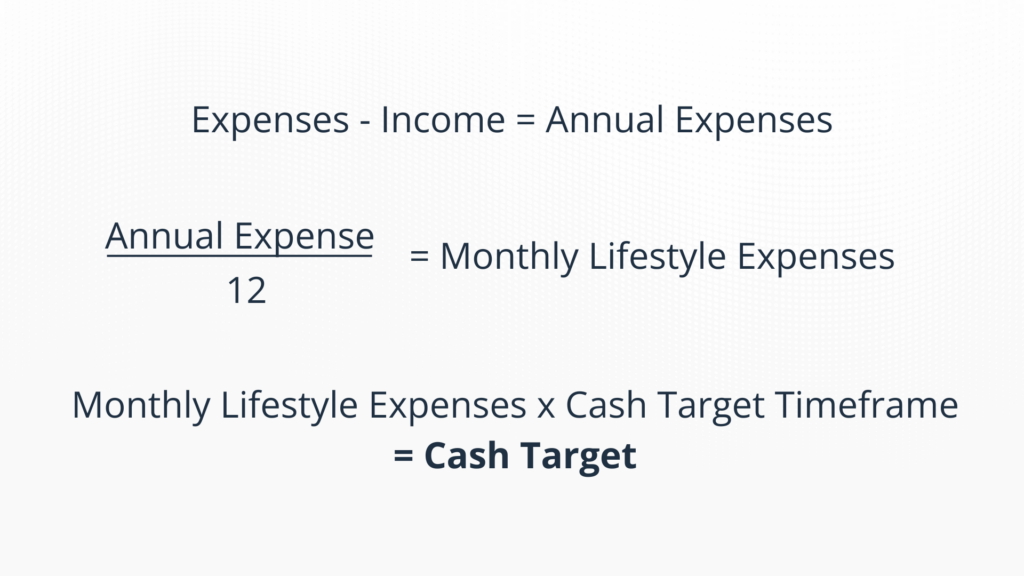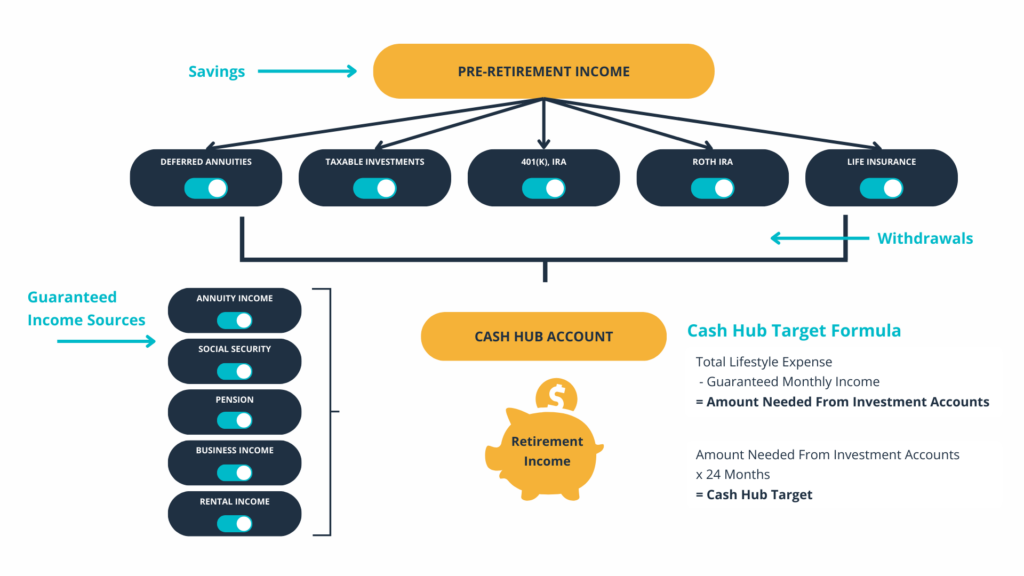At Gatewood Wealth Solutions, we pride ourselves on keeping our clients “Bear Market Ready, but Bull Market Positioned.” By this, we mean that we help clients calculate an emergency fund — what we call their “Cash Target” — seeks to protect them during down markets. Then, the rest goes into the market, where it can seek growth.
Our firm has worked hard to develop an approach that allows us to pinpoint exactly where that “sweet spot” is, based on clients’ expenses, life stages, and our investment committee’s outlook on the market. Our financial planning and investment management teams work closely together to ensure no stone goes unturned in making this assessment.
How do we come to this number, which we call a client’s Cash Target? We’re glad you asked.

Step 1: Determine the client’s total annual expenses.
We start by totaling the client’s annual expenses. These include lifestyle expenses, taxes (including federal, state, and property), insurance, liabilities, charitable giving, insurance payments, and other costs. Then, we assess if there are expense changes during the “Cash Target Timeframe.” If so, we include this in the Cash Target formula by finding the cash target each year, as you will see in Step 4.
Step 2: Evaluate the client’s income.
Once we determine a number for annual income, we again review any year-to-year changes by identifying specific Cash Targets for each year if the income fluctuates.
Step 3: Incorporate the Investment Committee’s current Cash Target Timeframe.
Our Investment Committee regularly evaluates market conditions to make recommendations for ideal Cash Targets. For example, pre-pandemic, the general Cash Target was 24 months. By January 2021, our investment committee increased the target to 33 months. As you can see, the “Cash Target” — the amount we recommend clients keep on hand in cash — expanded as the market became more uncertain. And it will likely shrink back again as the market gains stability.
Step 4: Calculate the Cash Target
Next, we move on to the actual calculation. We know life (more precisely– income and expenses) is not the same year after year. Therefore, we developed a formula to consider those income or expense changes:
If no expense or income changes:
If an expense or income changes:
Year 1: Expenses – income = Annual Expense /12 = Monthly Lifestyle Expense X 12 = Year 1 Cash Target
+ Year 2: Expenses – income = Annual Expense /12 = Monthly Lifestyle Expense X 12 = Year 2 Cash Target
= Cash Hub Target
Note: If more than 24-month Cash Target, we would continue the process (+ Year 3 Expenses – income = Annual Expense /12 = Monthly Lifestyle Expense X 12 = Year 2 Cash Target).
Step 5: Fund the Cash Hub Account
Once we have the Cash Target amount, we calculate and fund the Cash Hub Account. For example, if your cash target is $240,000 and you have $100,000 in your checking/savings account, we would fund the Cash Hub Account at our firm with $140,000. However, the big questions are – which accounts do you pull from and when? To answer this, we consider tax qualification and tax brackets, liquidity concerns, and legacy goals.
The cash hub account is just one small part of our overall distribution planning approach, which you can see below. Our planning team constantly turns these funnels on and off based on our clients’ specific financial situations and life goals. We can make sure we correctly put our clients’ money to work for them while maximizing their tax-saving strategies.
All investing involves risk, including the possible loss of principal. No strategy assures success or protects against loss. There is no guarantee that a diversified portfolio will enhance overall returns or outperform a non-diversified portfolio. Diversification does not protect against market risk.
The opinions voiced in this material are for general information only and are not intended to provide specific advice or recommendations for any individual. All performance referenced is historical and is no guarantee of future results. All indices are unmanaged and may not be invested directly.
Securities and advisory services are offered through LPL Financial, a registered investment advisor, Member FINRA/SIPC.






